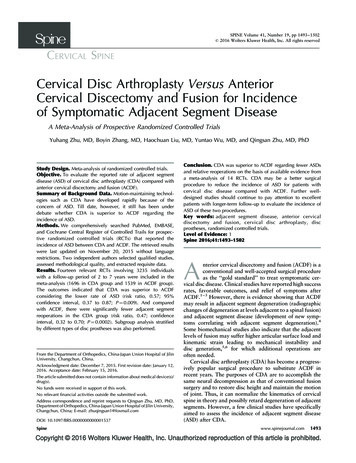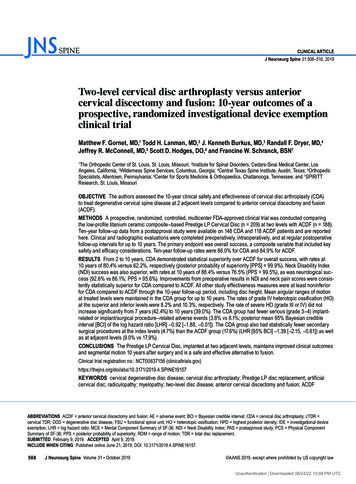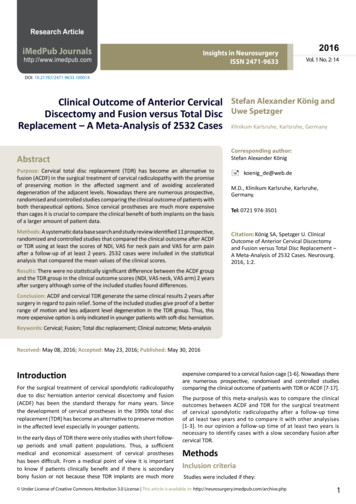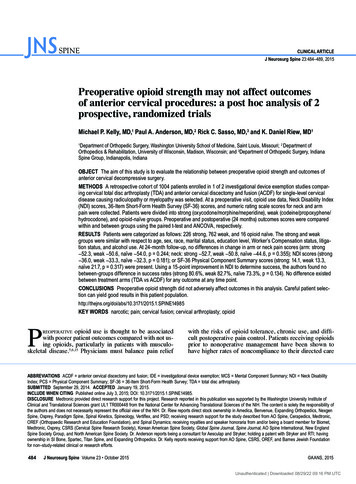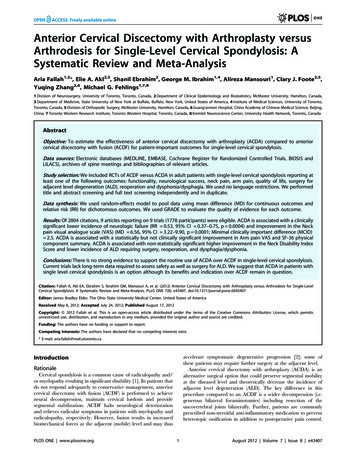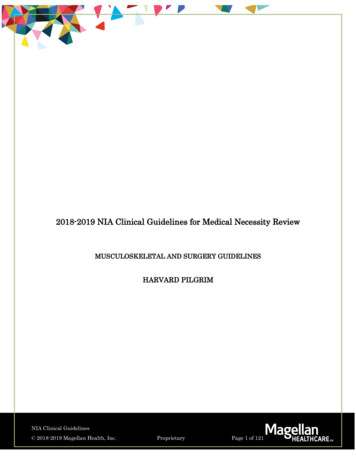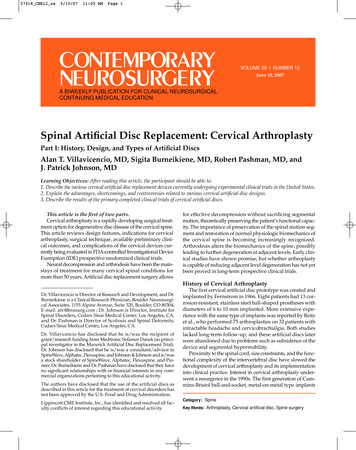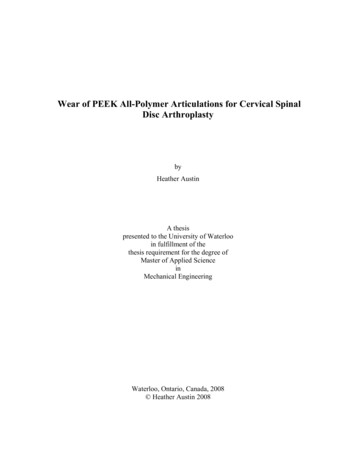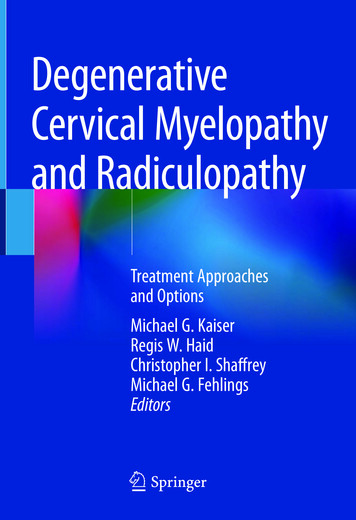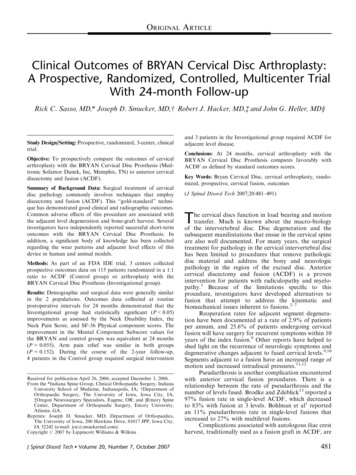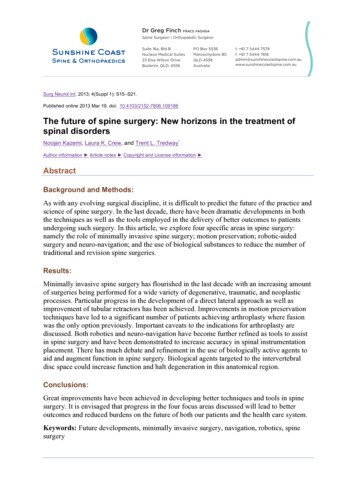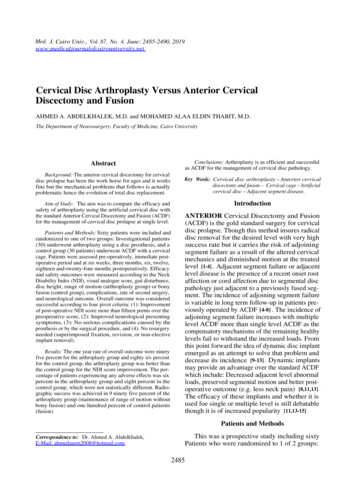
Transcription
Med. J. Cairo Univ., Vol. 87, No. 4, June: 2485-2490, l Disc Arthroplasty Versus Anterior CervicalDiscectomy and FusionAHMED A. ABDELKHALEK, M.D. and MOHAMED ALAA ELDIN THABIT, M.D.The Department of Neurosurgery, Faculty of Medicine, Cairo UniversityAbstractConclusions: Arthroplasty is as efficient and successfulas ACDF for the management of cervical disc pathology.Background: The anterior cervical discectomy for cervicaldisc prolapse has been the work horse for ages and it worksfine but the mechanical problems that follows is actuallyproblematic hence the evolution of total disc replacement.Key Words: Cervical disc arthroplasty – Anterior cervicaldiscectomy and fusion – Cervical cage – Artificialcervical disc – Adjacent segment disease.Aim of Study: The aim was to compare the efficacy andsafety of arthroplasty using the artificial cervical disc withthe standard Anterior Cervical Discectomy and Fusion (ACDF)for the management of cervical disc prolapse at single level.Patients and Methods: Sixty patients were included andrandomized to one of two groups: Investigational patients(30) underwent arthroplasty using a disc prosthesis, and acontrol group (30 patients) underwent ACDF with a cervicalcage. Patients were assessed pre-operatively, immediate postoperative period and at six weeks, three months, six, twelve,eighteen and-twenty-four months postoperatively. Efficacyand safety outcomes were measured according to the NeckDisability Index (NDI), visual analogue score, gait disturbance,disc height, range of motion (arthroplasty group) or bonyfusion (control group), complications, rate of second surgery,and neurological outcome. Overall outcome was consideredsuccessful according to four pivot criteria: (1): Improvementof post-operative NDI score more than fifteen points over thepreoperative score, (2): Improved neurological presentingsymptoms, (3): No serious complications caused by theprosthesis or by the surgical procedure, and (4): No resurgeryneeded (superimposed fixation, revision, or non-electiveimplant removal).Results: The one year rate of overall outcome were ninetyfive percent for the arthroplasty group and eighty six percentfor the control group, the arthroplasty group was better thanthe control group for the NDI score improvement. The percentage of patients experiencing any adverse effects was sixpercent in the arthroplasty group and eight percent in thecontrol group, which were not statistically different. Radiographic success was achieved in 9 ninety five percent of thearthroplasty group (maintenance of range of motion withoutbony fusion) and one hundred percent of control patients(fusion).IntroductionANTERIOR Cervical Discectomy and Fusion(ACDF) is the gold standard surgery for cervicaldisc prolapse. Though this method insures radicaldisc removal for the desired level with very highsuccess rate but it carries the risk of adjoiningsegment failure as a result of the altered cervicalmechanics and diminished motion at the treatedlevel [1-4] . Adjacent segment failure or adjacentlevel disease is the presence of a recent onset rootaffection or cord affection due to segmental discpathology just adjacent to a previously fused segment. The incidence of adjoining segment failureis variable in long term follow-up in patients previously operated by ACDF [4-8] . The incidence ofadjoining segment failure increases with multiplelevel ACDF more than single level ACDF as thecompensatory mechanisms of the remaining healthylevels fail to withstand the increased loads. Fromthis point forward the idea of dynamic disc implantemerged as an attempt to solve that problem anddecrease its incidence [9-13] . Dynamic implantsmay provide an advantage over the standard ACDFwhich include: Decreased adjacent level abnormalloads, preserved segmental motion and better postoperative outcome (e.g. less neck pain) [8,11,13] .The efficacy of these implants and whether it isused foe single or multiple level is still debatablethough it is of increased popularity [11,13-15] .Patients and MethodsThis was a prospective study including sixtyPatients who were randomized to 1 of 2 groups:Correspondence to: Dr. Ahmed A. Abdelkhalek,E-Mail: ahmedasem2008@hotmail.com2485
2486Investigational group (30) underwent arthroplastyusing an artificial disc and control patients (30)underwent ACDF with a cervical PEEK cage.Patients were operated at Cairo University Hospitalsfrom May 2016 till December 2018, they wereevaluated pre-operatively, immediate post-operativeperiod for improvement, complications and wounds,then at 6 weeks, 3, 6, 12, 18 and 24 months postoperatively.Inclusion criteria:Age range from 18 to 50 years, single levelcervical disc disease, soft disc herniation. Exclusioncriteria included: Age above 50 years, multiplelevel disc disease, recurrent cases or previousACDF, cervical myelopathy, Ossified PosteriorLongitudinal Ligament (OPLL) and advanced cervical spondylosis. Evaluation pf patients were doneby full history taking, pain distribution and intensity, full examination and past history, occupationalhistory and precise neurological examination. VASfor neck pain and brachialgia, scoring was donepreoperatively using the 10 point scoring systemwith 0 no pain and 10 severe pain, the NeckDisability Index (NDI) was also used to assess thedisability caused by the disease and its impact onpatients daily activity, the score ranges from nodisability (0) to totally disabled (5) and it stronglycorrelates to the vas score. Radiological assessmentwith plain radiographs for range of motion, presence of osteophytes-discs complexes, disc heightand advanced spondylosis. MRI scans for diagnosisof the affected level, spinal compression, presenceof soft disc or osteophytes and presence of OPLL.All patients were operated by the anterior approach,the target level is marked using C-arm, neck isextended with padding below shoulders to aid neckextension, transverse collar incision at the desiredlevel, dissection and discectomy using the operativemicroscope, then either artificial disc or ACDF isdone. Post-operatively patients were assessed clinically for any adverse effects (e.g. Neurologicaldeficits), VAS and NDI were done immediate postand periodically with X-ray assessment at the sameintervals, efficacy and safety outcomes were measured according to the Neck Disability Index (NDI),visual analogue score for axial pain and radiculopathy, disc height preservation, range of cervicalmotion (arthroplasty group) or fusion (controlgroup), Adverse Events (AEs), additional surgeries,and neurological status. Treatment was consideredsuccessful when all four of the following standardswere fulfilled: (1): 15 points improvement of theNDI over the pre-operative score, (2): Clinicalpatient improvement, (3): No serious complicationsCervical Arthroplasty Vs Anterior Cervical Discectomycaused by the implant and (4): No resurgery suchas adjuvant fixation, revision, or emergency implantremoval.ResultsFrom the sixty patients included in the studythere was 53 males and seven females, age rangedfrom 18 to 50 years, forty-eight complained ofneck pain (80%), all cases had radiculopathy i.e.brachialgia, sensory deficits were present in sevencases (11.6%) and one patient had motor deficit(hand grip weakness). The one year success ratewas 95% for the arthroplasty group and 86% forthe control group, the arthroplasty group was betterthan the control group for NDI outcome. Thepercent of complications for both groups were notstatistically different (6.8 and 8 percent respectively). Radiographic success was achieved in 95.0%of the arthroplasty patients (maintenance of rangeof cervical motion without fusion) and 100% ofthe control patients (fusion). Complications included superficial wound infection (2 cases 3.3%),sensory deficit in 24 cases (40%) represented withnumbness with only 8 cases it was persistent.Fusion rate60%100%82%6 months12 months18 monthsChart (1): Fusion rate in ACDF group.Fusion rate0%1.7%5%6 months12 months18 monthsChart (2): Fusion rate for the arthroplasty group.
Ahmed A. Abdelkhalek & Mohamed A. ThabitFig. (1): A 37 year old male patient complained of right brachialgia operated by arthroplasty at C6/7 level.Fig. (2): A female patient with shoulder pain and myelopathy underwent 3/4 arthroplasty.2487
2488Cervical Arthroplasty Vs Anterior Cervical DiscectomyTable (1): ACDF group with NDI months10128121081884840Mild (5-14)Moderate (15-24)Severe ( 24)Table (2): Arthroplasty group with NDI months1214418841242810MildModerateSevereTable (3): VAS score for neck pain in ACDF group.TimingPre1.51618operative months months year monthsVAS2244Low (1-3)Moderate (4-6)High (7-10)4188121261611318111Table (4): VAS score for neck pain in arthroplasty ionIn this study, we tried to clarify if there was areal benefit for the replacement of cage fusion withthe arthroplasty device, is it worth it or not due tothe financial brunt of the new technology in adeveloping country as Egypt which is an importantissue. Though we couldn't address the problem ofadjacent segment failure due to the short followup period which was the main justification to shiftto the arthroplasty device so we compared the neckdisability, pain and fusion rate as these were alsoimportant factors for the patient and the outcomeof the procedure.In Several series, it was found that there werebetter neurologic outcomes with arthroplasty versusconventional anterior approach. Mummaneni etal., reported statistically significant neurologicimprovement in patients undergoing arthroplastyusing prestige ST cervical disc compared to ACDF,in our study there was no difference regarding theneurological status and actually neurological improvement is dependent on the procedure not theprosthesis [22] . Heller et al., also showed statisticallybetter improvement in NDI score, and overalloutcome in patients who had surgery using Bryancervical arthroplasty device versus ACDF [15] .Also patients with arthroplasy returned to work anaverage of 2 weeks earlier than ACDF subjects,but there was no statistical discrepancy in thepercentage of adjoining segment failure [15] . Inour study the NDI score for the arthroplasty groupwere better at the 1.5 and six months period morethan the ACDF group but at one year period it wasalmost the same which means that the arthroplastygroup has better short term functional outcome. Inanother series, it showed no statistical significantdiscrepancy in neurologic outcomes, blood loss,surgical time, duration of hospital stay, NDI, VAS,or adjacent segment failure compared with ACDFpatients [9] .In our study the VAS score for neck pain wasby far better for the arthroplasty group than theACDF with shorter period to return to work ornormal activity.Gore and Sepic included 50 patients in theirwork following them up for up to 21 years following ACDF, [13] forty-eight of them had new discdisease findings on radiographic scans, but onlyeight needed re-surgery due to the presence ofsignificant radiculopathy, or cord compressionsigns. Baba et al., in their series followed-up overone hundred patients (106), 42 had one-level fusion,52 with double level fusion, twelve had three-levelfusion) for up to 8.5 years, [3] adjoining segmentfailure occurred at 39% rate which was a significant rate. Herkowitz et al., had incidence of 41%adjacent segment failure following single levelACDF [16] .The present data can't yet prove or deny ifarthroplasty will diminish or erase the risk ofadjacent segment disease. the follow-up periodsutilized up till now didn't raise enough long-termevidence to clarify this important issue. RecentlyNunley et al., examined the outcomes of patientsthat were included in five different cervical arthroplasty trials with follow-up period from 4 to 7years they showed a 2.3% rate of clinically symptomatic adjoining segment disease [17] . WhileMurrey et al., produced data that there was nowhatsoever statistical discrepancy between ACDFand arthroplasty in the issue of adjacent segmentfailure.Adjacent to cervical fusion, pressure inside thedisc increases by approximately 50% in the contiguous adjacent segment and 125% in the other
Ahmed A. Abdelkhalek & Mohamed A. Thabitdistal levels [18] . When comparing arthroplasty toconventional ACDF, most studies with follow-upperiods of two years or more did not find anysignificant difference concerning adjoining segmentfailure [19,20] . A study by Coric et al., [21] did finda significant increase in adjacent segment failurein their series on single level disc disease operatedby ACDF compared to the single level arthroplastygroup, at 2-year follow-up. Dang et al., [22] statedthere was significant increase in adjacent segmentfailure after double level fusion compared to singlelevel fusion.Fay et al., [23] studied the differences betweenarthroplasty and ACDF in double level degenerativedisease. Cervical arthroplasty preserved the rangeof motion at the operated levels and gave similarclinical results as ACDF at nearly 40 months follow-up intervals after surgery [23] . In a prospectiverandomized study at several centers double levelartificial disc replacement with the Mobi-C cervicalartificial disc against ACDF, four year resultsclarified a significantly higher improvement in theNDI scores, patient content, and overall betteroutcome in the arthroplasty group. Also the ACDFpatients had a higher incidence of second surgery(15.2% vs. 4%) and radiographic adjacent segmentfailure [23] . also the incidence of radiographic discdisease was found to be 86% in the ACDF groupcompared with 42% in the arthroplasty group [23]davis RJ et al., used the Mobi-C disc prosthesis inpatients and stated that it maintained the segmentalrange of motion for a follow-up period of 48months. Similarly Radcliff et al., in a multiplecenter study reported a significantly higher improvement in NDI scores, shorter hospital stay,and better patient satisfaction at five year followup in patients treated with a 2-level arthroplastycompared to a double level ACDF [24] . Moreover,the resurgery incidence in this study was muchlower for the arthroplasty group (4%) in comparisonto the ACDF group (16%) at the target level, andat adjacent levels (3. 1% vs. 11.4%) [24] .Conclusion:Arthroplasty is superior to ACDF in outcomeregarding NDI and VAS scoring systems but regarding adjacent segment failure needs long termperiod of follow-up with the same adverse effectsfor both procedures.References1- ANDERSON P.A., SASSO R.C. and RIEW K.D.: Comparison of adverse events between the Bryan artificialcervical disc and anterior cervical arthrodesis. Spine, 33:1305-12, 2008.24892- AGRILLO U., FACCIOLI F., FACHINETTI P., GAMBARDELLA G., GUIZZARDI G. and PROFETA G.:Guidelines for the diagnosis and management of thedegenerative diseases of the cervical spine. J. Neurol.Sci., 43: 11-4, 1999.3- BABA H., FURUSAWA N., IMURA S., KAWAHARAN., TSUCHIYA H. and TOMITA K.: Late radiographicfindings after anterior cervical fusion for spondyloticmyeloradiculopathy. Spine, 18: 2167-73, 1993.4- BOHLMAN H.H., EMERY S.E, GOODFELLOW D.B.and JONES P.K. : Robinson anterior cervical discectomyand arthrodesis for cervical radiculopathy. Long-termfollow-up of one hundred and twenty-two patients. J.Bone. Joint. Surg. Am., 75: 1298-307, 1993.5- BRODKE D.S. and ZDEBLICK T.A. : Modified SmithRobinson procedure for anterior cervical discectomy andfusion. Spine, 17: S427-30, 1992.6- CAO J.M., ZHANG Y.Z., SHEN Y., XU J.X., DING W.Y.,YANG D.L., et al.: Clinical and radiological outcomesof modified techniques in Bryan cervical disc arthroplasty.J. Clin. Neurocsci., 18: 1308-12, 2011.7- CAVANAUGH D.A., NUNLEY P.D., KERR E.J., 3 rd ,WERNER D.J. and JAWAHAR A.: A delayed hypersensitivity to metal ions after cervical disc arthroplasty. Spine,34: 262-5, 2009.8- CHEN J., WANG X., BAI W., SHEN X. and YUAN W.:Prevalence of heterotopic ossification after cervical totaldisc arthroplasty: A meta-analysis. Eur. Spine. J., 21: 67480, 2012.9- CORIC D., NUNLEY P.D. and GUYER R.D.: Prospective,randomized, multicenter study of cervical arthroplasty:269 patients from the Kineflex C artificial disc investigational device exemption study with a minimum 2-yearfollow-up: Clinical article. J. Neurosurg. Spine, 15: 34858, 2011.10- DATTA J.C., JANSSEN M.E., BECKHAM R. and PONCE C.: Sagittal split fractures in multilevel cervicalarthroplasty using a keeled prosthesis. J. Spinal. Disord.Tech., 20: 89-92, 2007.11- GOFFIN J., VAN CALENBERGH F., VAN LOON J.,CASEY A., KEHR P., LIEBIG K., et al.: Intermediatefollow-up after treatment of degenerative disc diseasewith the Bryan cervical disc prosthesis: Single-level andbi-level. Spine, 28: 2673-8, 2003.12- GOFFIN J.: Complications of cervical disc arthroplasty.Semin. Spine Surg., 18: 87-97, 2006.13- GORE D.R., SEPIC S.B. and GARDNER G.M.: Neckpain: A long-term follow-up of 205 patients. Spine, 12:1-5, 1987.14- GUYER R.D., SHELLOCK J., MACLENNAN B., HANSCOM D., KNIGHT R.Q., MCCOMBE P., et al.: Earlyfailure of metal-on-metal artificial disc prostheses associated with lymphocytic reaction: Diagnosis and treatmentexperience in four cases. Spine, 36: E492-7, 2011.15- HELLER J.G., SASSO R.C., PAPADOPOULOS S.M.,ANDERSON P.A., FESSLER R.G., HACKER R.J., etal.: Comparison of the BRYAN cervical disc arthroplastywith anterior cervical decompression and fusion: Clinicaland radiographic results of a randomized, controlled,clinical trial. Spine, 34: 101-7, 2009.
249016- HERKOWITZ H., KURZ L. and OVERHOLT D.: Surgicalmanagement of cervical soft disc herniation: A comparisonbetween the anterior and posterior approach. Spine, 15:1026-30, 1990.17- NUNLEY P.D., CORIC D., JAWAHAR A., KERR E.J.,GORDON C., UTTER P.A., et al.: Total Disc Replacementin Cervical Spine: 4-7 years follow-up for primary outcomes and symptomatic adjacent segment disease. Cervical. Spine. Res. Soc., 2011.18- DMITRIEV A.E., CUNNINGHAM B.W., HU N., SELLG., VIGNA F. and MCAFEE P.C.: Adjacent level intradiscal pressure and segmental kinematics following a cervicaltotal disc arthroplasty: An in vitro human cadaveric model.Spine (Phila Pa 1976), 30: 1165-72, 2005.19- NUNLEY P.D., JAWAHAR A., KERR E.J. 3 rd , et al.:Factors affecting the incidence of symptomatic adjacentlevel disease in cervical spine after total disc arthroplasty:2-to 4-year follow-up of 3 prospective randomized trials.Spine (Phila Pa 1976), 37: 445-51, 2012.20- MALDONADO C.V., PAZ R.D. and MARTIN C.B.:Adjacent-level degeneration after cervical disc arthroplastyversus fusion. Eur. Spine. J., 20 (suppl 3): S403-S7, 2011.Cervical Arthroplasty Vs Anterior Cervical Discectomy21- CORIC D., NUNLEY P.D., GUYER R.D., et al.: Prospective, randomized, multicenter study of cervical arthroplasty: 269 patients from the Kineflex C artificial discinvestigational device exemption study with a minimum2-year follow-up: Clinical article. J. Neurosurg. Spine,15: 348-58, 2011.22- DANG A.B.C., HU S.S. and TAY B.K.B.: Biomechanicsof the anterior longitudinal ligament during 8g whiplashsimulation following single- and contiguous two-levelfusion: A finite element study. Spine. (Phila Pa 1976),33: 607-11, 2008.23- FAY L.Y., HUANG W.C., TSAI T.Y., et al.: Differencesbetween arthroplasty and anterior cervical fusion in twolevel cervical degenerative disc disease. Eur. Spine. J.,23: 627-34, 2014.24- RADCLIFF K., CORIC D. and ALBERT T.: Five-yearclinical results of cervical total disc replacement comparedwith anterior discectomy and fusion for treatment of 2level symptomatic degenerative disc disease: A prospective, randomized, controlled, multicenter investigationaldevice exemption clinical trial. 25: 213-24, 2016.
for the management of cervical disc prolapse at single level. Patients and Methods: Sixty patients were included and disc removal for the desired level with very high . Timing outcome in patients who had surgery using Bryan Pre- operative 1.5 months cervical arthroplasty device versus ACDF 6 months 12 months NDI score 1 year 18 months 1.5
